
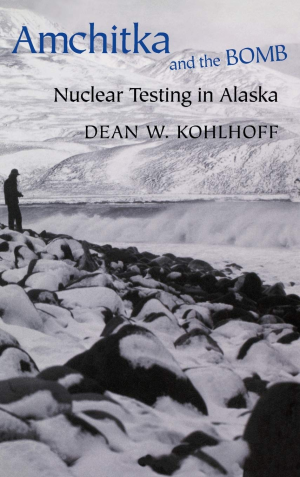 |
Amchitka and the Bomb: Nuclear Testing in Alaska
by Dean W. Kohlhoff
Published: August, 2002 "Amchitka and the Bomb tells a harrowing story of the struggle of private citizens and small environmental groups to counter the weight of the federal government. It adds immeasurably to our understanding of the nuclear history of the United States. Its concise interweaving of the military, scientific, economic, and social implications surrounding the nuclear explosions on Amchitka Island exposes the unpleasant consequences of allowing treasured national values to become victim to political necessity." —via Publisher
|
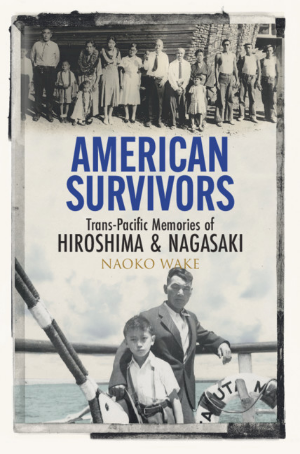 |
American Survivors Trans-Pacific : Memories of Hiroshima & Nagasaki
by Naoko Wake
Published: June, 2021 "Using more than 130 oral histories of Japanese American and Korean American survivors, their family members, community activists, and physicians - most of which appear here for the first time - Naoko Wake reveals a cross-national history of war, illness, immigration, gender, family, and community from intimately personal perspectives. American Survivors brings to light the history of Hiroshima and Nagasaki that connects, as much as separates, people across time and national boundaries." —via Publisher
|
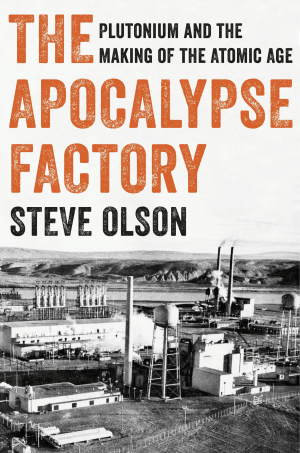 |
The Apocalypse Factory: Plutonium and the Making of the Atomic Age
by Steve Olsonf
Published: July, 2020 "It would begin with plutonium, the first element ever manufactured by humans. In a matter of months, a city designed to produce this dangerous material arose from the desert of eastern Washington State. Plutonium powered the bomb that dropped on Nagasaki on August 9, 1945 (a target selected in almost arbitrary fashion). And the work of Glenn Seaborg, Enrico Fermi, and hundreds of thousands of others—the physicists, engineers, laborers, and support staff of the Hanford Nuclear Facility—would remain the basis of the entire US nuclear arsenal during the Cold War and into the present." —via Publisher
|
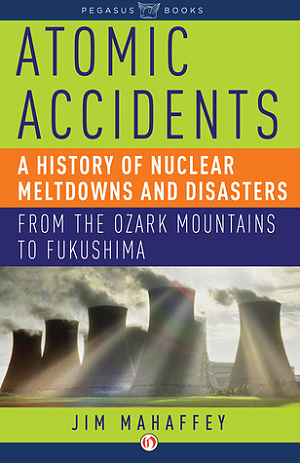 |
Atomic Accidents: A History of Nuclear Meltdowns and Disasters: From the Ozark Mountains to Fukushima
by James Mahaffey
Published: February, 2014 "Long-time advocate of continued nuclear research and nuclear energy James Mahaffey looks at each incident in turn and analyzes what happened and why, often discovering where scientists went wrong when analyzing past meltdowns. Every incident, while taking its toll, has led to new understanding of the mighty atom—and the fascinating frontier of science that still holds both incredible risk and great promise." —via Publisher
|
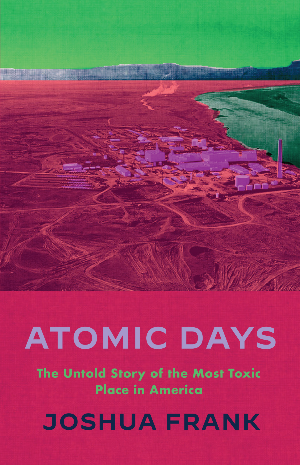 |
Atomic Days: The Untold Story of the Most Toxic Place in America
by Joshua Frank
Published: September, 2022 "The Hanford Nuclear Reservation in Washington state has become the most toxic site in the Western Hemisphere, yet most Americans are in the dark about the damage their government's nuclear obsession has wrought on the environment and their tax dollars. Once home to the United States's largest plutonium production site, the Hanford Nuclear Reservation in Washington state is laced with 56 million gallons of radioactive waste. The threat of an explosive accident at Hanford is all too real—an event that could be more catastrophic than Chernobyl." —via Publisher
|
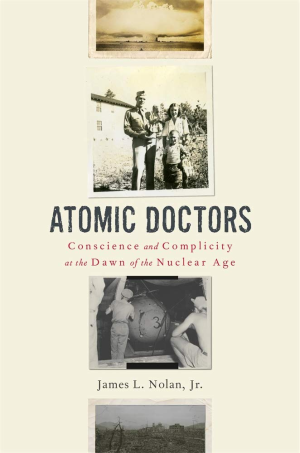 |
Atomic Doctors: Conscience and Complicity at the Dawn of the Nuclear Age
by James L. Nolan Jr.
Published: August, 2020 "After his father died, James L. Nolan, Jr., took possession of a box of private family materials. To his surprise, the small secret archive contained a treasure trove of information about his grandfather's role as a doctor in the Manhattan Project. Dr. Nolan, it turned out, had been a significant figure. A talented obgyn radiologist, he cared for the scientists on the project, organized safety and evacuation plans for the Trinity test at Alamogordo, escorted the "Little Boy" bomb from Los Alamos to the Pacific Islands, and was one of the first Americans to enter the irradiated ruins of Hiroshima and Nagasaki." —via Publisher
|
 |
Atomic Geography: A Personal History of the Hanford Nuclear Reservation
by Melvin R. Adams
Published: November, 2016 "In what Adams considers his most successful project, he helped determine the initial scope of the soil and solid waste cleanup. His group also designed and tested a marked, maintenance-free disposal barrier, expanded a network of groundwater monitoring wells, and developed a pilot scale pump and treatment plant. Adams shares his perspective on leaking high-level waste storage tanks, dosimeters, and Hanford's obsession with safety." —via Publisher
|
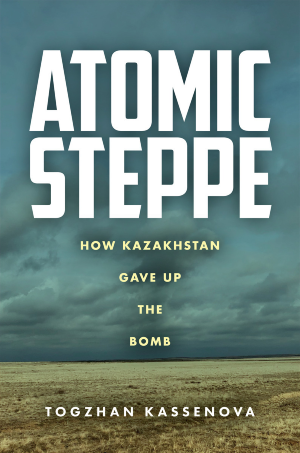 |
Atomic Steppe: How Kazakhstan Gave Up the Bomb
by Togzhan Kassenova
Published: February, 2022 "This book takes us inside Kazakhstan's extraordinary and little-known nuclear history from the Soviet period to the present. For Soviet officials, Kazakhstan's steppe was not an ecological marvel or beloved homeland, but an empty patch of dirt ideal for nuclear testing. Two-headed lambs were just the beginning of the resulting public health disaster for Kazakhstan--compounded, when the Soviet Union collapsed, by the daunting burden of becoming an overnight nuclear power. Equipped with intimate personal perspective and untapped archival resources, Togzhan Kassenova introduces us to the engineers turned diplomats, villagers turned activists, and scientists turned pacifists who worked toward disarmament." —via Publisher
|
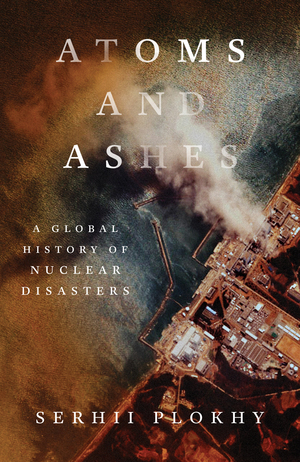 |
Atoms and Ashes: A Global History of Nuclear Disasters
by Serhii Plokhy
Published: May, 2022 "In Atoms and Ashes, Serhii Plokhy recounts the dramatic history of Three Mile Island and five more accidents that that have dogged the nuclear industry in its military and civil incarnations: the disastrous fallout caused by the testing of the hydrogen bomb in the Bikini Atoll in 1954; the Kyshtym nuclear disaster in the USSR, which polluted a good part of the Urals; the Windscale fire, the worst nuclear accident in the UK’s history; back to the USSR with Chernobyl, the result of a flawed reactor design leading to the exodus of 350,000 people; and, most recently, Fukushima in Japan, triggered by an earthquake and a tsunami, a disaster on a par with Chernobyl and whose clean-up will not take place in our lifetime." —via Publisher
|
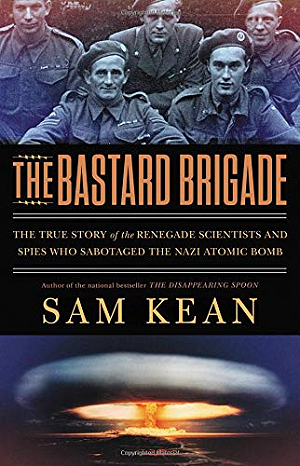 |
The Bastard Brigade: The True Story of the Renegade Scientists and Spies Who Sabotaged the Nazi Atomic Bomb
by Sam Kean
Published: July, 2019 "The gripping, untold story of a renegade group of scientists and spies determined to keep Adolf Hitler from obtaining the ultimate prize: a nuclear bomb. In the middle of building an atomic bomb, the leaders of the Manhattan Project were alarmed to learn that Nazi Germany was far outpacing the Allies in nuclear weapons research." —via Publisher
|
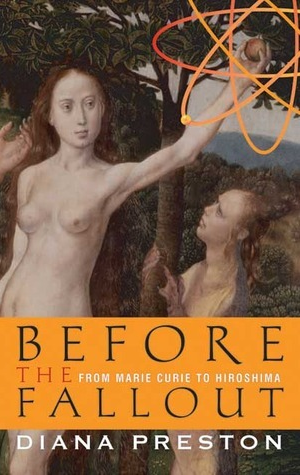 |
Before the Fallout: From Marie Curie to Hiroshima
by Serhii Plokhy
Published: April, 2005 "Weaving together history, science, and biography, Diana Preston chronicles a human chain reaction of scientists and leaders whose discoveries and decisions forever changed our lives. The early decades of the 20th century brought Einstein's relativity theory, Rutherford's discovery of the atomic nucleus, and Heisenberg's quantum mechanics, and scientists of many nations worked together to tease out the secrets of the atom. Only 12 years before Hiroshima, one leading physicist dismissed the idea of harnessing energy from atoms as "moonshine." —via Publisher Then, on the eve of World War II, the power of atomic fission was revealed, alliances were broken, friendships sundered, and science co-opted by world events." —via Publisher
|
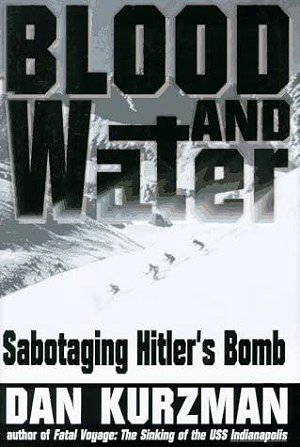 |
Blood and Water: Sabotaging Hitler's Bomb
by Dan Kurzman
Published: January, 1997 "This gripping saga recreates four attempts undertaken to destroy a hydroelectric plant in a remote, mountainous region of southern Norway. Commandeered by the Nazis in the spring of 1941, Norsk Hydro plant was the world's largest producer of deuterium oxide, or heavy water, a vital ingredient in the construction of the bomb. Pieced together from survivors' accounts in Norway & other primary sources, including the military archives of three countries, this is the story of the clandestine two-year ordeal, told in dramatic heart-stopping detail by Dan Kurzman, author of several best-selling nonfiction thrillers about WWII." —via Publisher
|
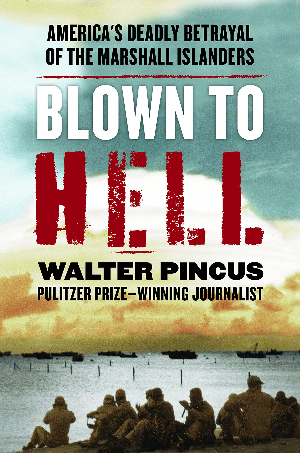 |
Blown to Hell: America's Deadly Betrayal of the Marshall Islanders
by Walter Pincus
Published: November, 2021 "In Blown to Hell, Pulitzer Prize-winning journalist Walter Pincus tells for the first time the tragic story of the Marshallese people caught in the crosshairs of American nuclear testing. From John Anjain, a local magistrate of Rongelap Atoll who loses more than most; to the radiation-exposed crew of the Japanese fishing boat the Lucky Dragon; to Dr. Robert Conard, a Navy physician who realized the dangers facing the islanders and attempted to help them; to the Washington power brokers trying to keep the unthinkable fallout from public view . . . Blown to Hell tells the human story of America's nuclear testing program." —via Publisher
|
 |
Bombing the Marshall Islands: A Cold War Tragedy
by Keith M. Parsons & Robert A. Zaballa
Published: August, 2017 "During the Cold War, the United States conducted atmospheric tests of nuclear weapons in the Marshall Islands of the Pacific. The total explosive yield of these tests was 108 megatons, equivalent to the detonation of one Hiroshima bomb per day over nineteen years. These tests, particularly Castle Bravo, the largest one, had tragic consequences, including the irradiation of innocent people and the permanent displacement of many native Marshallese. Keith M. Parsons and Robert Zaballa tell the story of the development and testing of thermonuclear weapons and the effects of these tests on their victims and on the popular and intellectual culture." —via Publisher
|
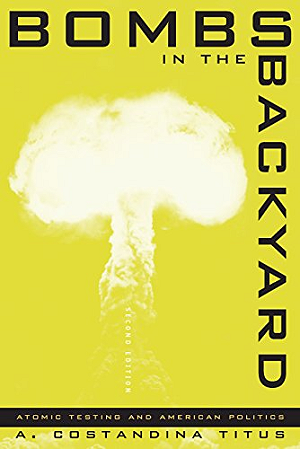 |
Bombs in the Backyard: Atomic Testing and American Politics
by Alice Costandina Titus
Published: February, 2001 "On January 27, 1951, the first atomic weapon was detonated over a section of desert known as Frenchman Flat in southern Nevada, providing dramatic evidence of the Nevada Test Site's beginnings. Fifty years later, author A. Costandina Titus reviews contemporary nuclear policy issues concerning the continued viability of that site for weapons testing. Titus has updated her now-classic study of atomic testing with fifteen years of political and cultural history, from the mid-1980s Reagan-Gorbachev nuclear standoff to the authorization of the Nevada Test Site Research Center, a Desert Research Institute facility scheduled to open in 2001." —via Publisher
|
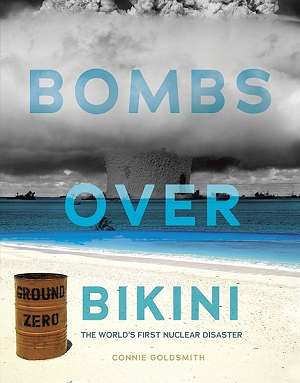 |
Bombs Over Bikini: The World's First Nuclear Disaster
by Connie Goldsmith
Published: April, 2014 "In 1946, as part of the Cold War arms race, the US military launched a program to test nuclear bombs in the Marshall Islands of the Pacific Ocean. From 1946 until 1958, the military detonated sixty-seven nuclear bombs over the region's Bikini and Enewetak Atolls. The twelfth bomb, called Bravo, became the world's first nuclear disaster. It sent a toxic cloud of radiation over Rongelap Atoll and other nearby inhabited islands." —via Publisher
|
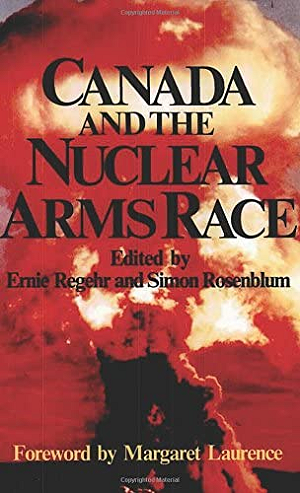 |
Canada and the Nuclear Arms Race
by Ernie Regehr
Published: January, 1983 "This book reports from the middle of the nuclear arms race, when the world's two superpowers, the US and the USSR, were adding increasingly sophisticated weapons to their arsenals, reaching a point where they could effectively wipe each other out many times over. Some of Canada's most distinguished critics of the nuclear arms race examine this drift to annihilation, show how Canada was contributing to it, and explain the policies that Canada could have adopted to encourage the reversal of the arms race." —via Publisher
|
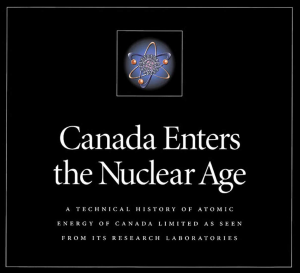 |
Canada Enters the Nuclear Age: A Technical History of Atomic Energy of Canada Limited as Seen from Its Research Laboratories
by Donald Geoffrey Hurst
Published: March, 1997 "Written by sixteen of Canada's pioneering nuclear scientists, the book focuses on Canada's nuclear program at AECL's laboratories at Chalk River, Ontario, and Whiteshell, Manitoba, between the years 1943 and 1985. Topics include the organization and operations of AECL's laboratories, nuclear safety and radiation protection, radioisotopes, basic research, development of the CANDU reactor, and the management of radioactive wastes. As well as providing a valuable historical perspective on Canadian science, Canada Enters the Nuclear Age offers useful guidance for innovative scientific development in the future, a future that will depend on developing and nurturing technically sophisticated industry." —via Publisher
|
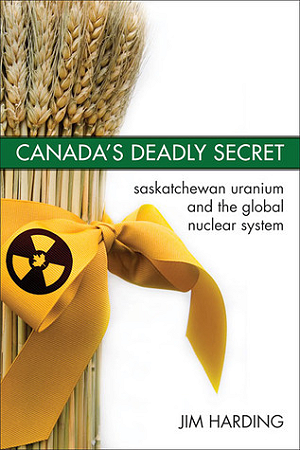 |
Canada's Deadly Secret: Saskatchewan Uranium and the Global Nuclear System
by Jim Harding
Published: October, 2007 "Covering everything from public health to nuclear weapons, this study looks at the impact of uranium from the perspective of its largest producer—Saskatchewan, Canada. Addressing aboriginal rights, the environment, the spread of cancer, and global cooperation, the analysis presents an alternative vision that links energy, health, and sovereignty to a sustainable and peaceful future." —via Publisher
|
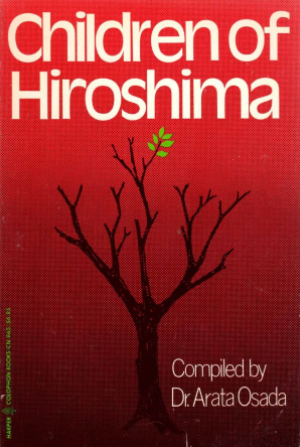 |
Children of Hiroshima
by Arata Osada
Published: June, 1980 "Children of the A-Bomb” is a collection of 67 testimonies of Hiroshima survivors culled from a total of more than 2,000, detailing the experiences of these innocent victims on 6th August 1945, as painfully remembered six years later, on what, in the Japanese way of counting, was the seventh anniversary of the event." —via Publisher
|
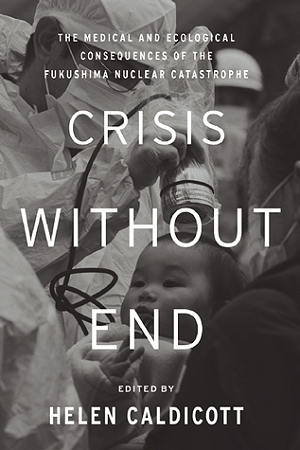 |
Crisis Without End: The Medical and Ecological Consequences of the Fukushima Nuclear Catastrophe
by Helen Caldicott
Published: August, 2014 "Leading experts from Japan, the United States, Russia, and other nations weigh in on the current state of knowledge of radiation-related health risks in Japan, impacts on the world’s oceans, the question of low-dosage radiation risks, crucial comparisons with Chernobyl, health and environmental impacts on the United States (including on food and newborns), and the unavoidable implications for the U.S. nuclear energy industry." —via Publisher
|
 |
Death in Life: Survivors of Hiroshima
by Robert Jay Lifton
Published: January, 1967 "In Japan, 'hibakusha' means 'the people affected by the explosion' - specifically, the explosion of the atomic bomb in Hiroshima in 1945. In this study, the winner of the 1969 National Book Award in Science studies the psychological effects of the bomb on 90,000 survivors. He sees this analysis as providing a last chance to understand - and be motivated to avoid - nuclear war. This compassionate treatment is a significant contribution to the atomic age." —via Publisher
|
 |
Deep Waters: The Ottawa River and Canada's Nuclear Adventure
by Kim Krenz
Published: April, 2004 "Deep Waters is an account of the principal events and personalities involved in the successful development of the Canadian nuclear power system (CANDU), an achievement that is arguably one of Canada's greatest scientific and technical successes. Kim Krenz also describes the early history of Deep River, a town built exclusively for the scientists and employees of the Chalk River Project, and considers the impact of the Project on the traditional communities of the Ottawa Valley." —via Publisher
|
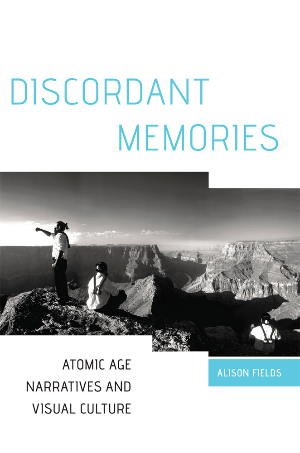 |
Discordant Memories: Atomic Age Narratives and Visual Culture
by Alison Fields
Published: February, 2020 "To reveal the layered complexities of nuclear remembrance, Fields analyzes photography, film, and artworks; offers close readings of media and testimonial accounts; traces site visits to atomic museums in New Mexico and Japan; and features artists who give visual form to evolving memories.According to Fields, such expressions of memory both inspire group healing and expose struggles with past trauma. Visual forms of remembrance—such as science museums, peace memorials, photographs, and even scars on human bodies—serve to contain or manage painful memories. And yet, the author claims, distinct cultures lay claim to vastly different remembrances of nuclear history." —via Publisher
|
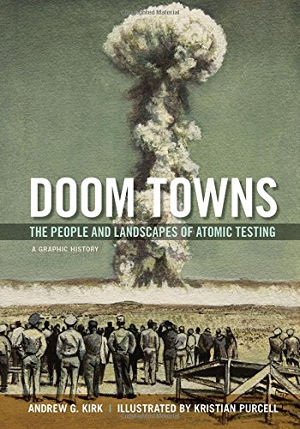 |
Doom Towns: The People and Landscapes of Atomic Testing, a Graphic History
by Andrew G. Kirk.
Published: September, 2016 "The history of atomic testing is usually told as a story about big technology, big science, and complex global politics. Doom Towns: The People and Landscapes of Atomic Testing explains critical technological developments and the policies that drove weapons innovation within the context of the specific environments and communities where testing actually took place. The book emphasizes the people who participated, protested, or were affected by atomic testing and explains the decision-making process that resulted in these people and places becoming the only locations and groups to actually experience nuclear warfare during the Cold War." —via Publisher
|
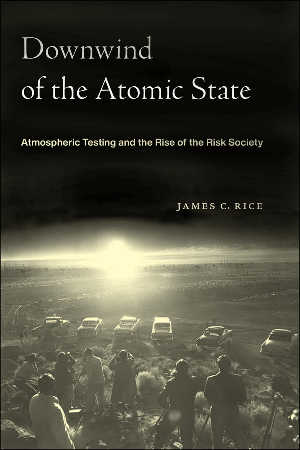 |
Downwind of the Atomic State: Atmospheric Testing and the Rise of the Risk Society
by James C. Rice
Published: March, 2023 "Downwind of the Atomic State focuses on the key decisions and events shaping the Commission’s mismanagement of radiological contamination in the region, specifically on how the risks of fallout were defined and redefined, or, importantly, not defined at all, owing to organizational mistakes and the impetus to keep atomic testing going at all costs. Rice shows that although Atomic Energy Commission officials understood open-air detonations injected radioactive debris into the atmosphere, they did not understand, or seem to care, that the radioactivity would irrevocably contaminate these communities." —via Publisher
|
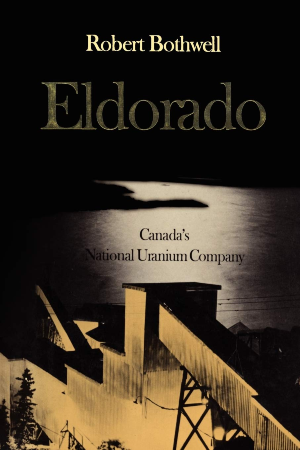 |
Eldorado: Canada's National Uranium Company
by Robert Bothwell
Published: October, 1984 "Robert Bothwell tells how Gilbert and Charlie LaBine, veteran Canadian prospectors, promoted and developed Eldorado Gold Mins Limited to produce radium. Thought to be the miracle cure for cancer, the rare mineral had a market price at the time of $75,000 per gram. Riches seemed a certainty and the company established a radium refinery at Port Hope, Ontario, in 1933." —via Publisher
|
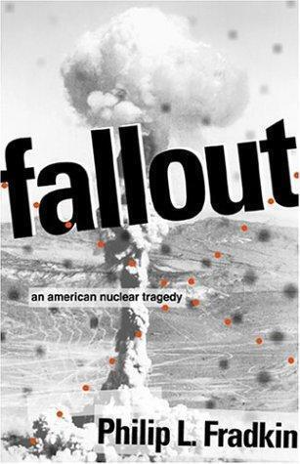 |
Fallout: An American Nuclear Tragedy
by Philip L. Fradkin
Published: November, 1988 "Tests in Nevada in the 1950's & 60s spread fallout that effected millions of Americans for decades to come. Fradkin covers the story of one court trail and the US govenrment's coverup. Citizens exposed to fallout from Nevada nuclear tests were assured of their safety by the government. Fallout reveals the courtroom drama that unfolded when high cancer rates led people to believe they had been betrayed." —via Publisher
|
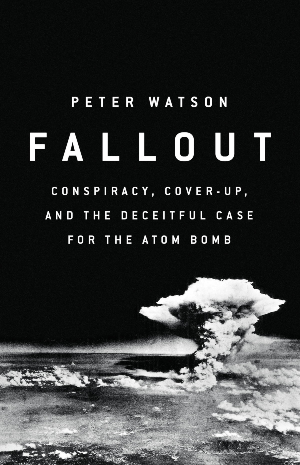 |
Fallout: Conspiracy, Cover-Up, and the Deceitful Case for the Atom Bomb
by Peter Watson
Published: September, 2018 "Fallout dismantles the conventional story of why the atom bomb was built. Peter Watson has found new documents showing that long before the Allied bomb was operational, it was clear that Germany had no atomic weapons of its own and was not likely to. The British knew this, but didn't share their knowledge with the Americans, who in turn deceived the British about the extent to which the Soviets had penetrated their plans to build and deploy the bomb.
The dark secret was that the bomb was dropped not to decisively end the war in the Pacific but to warn off Stalin's Russia, still in principle a military ally of the US and Britain. It did not bring a hot war to an abrupt end; instead it set up the terms for a Cold one to begin." —via Publisher
|
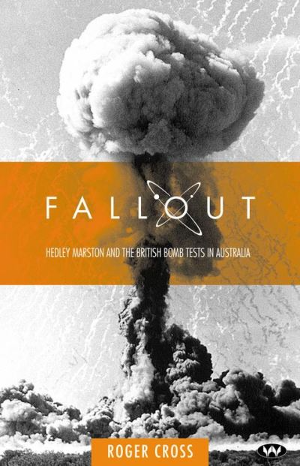 |
Fallout: Hedley Marston and the Atomic Bomb Tests in Australia
by Roger Cross
Published: December, 2001 "Fallout is the strange but true story of a celebrated Australian scientist's involvement in the 1956 British atomic bomb tests. Hedley Marston, an idol with his own feet of clay, was determined not only to reveal official lies and chicanery, but to expose as charlatans the Australian scientists who were appointed to protect the nation from any possible harm. Contrary to official pronouncements, radioactive fallout was blowing across the country and contaminating many towns and communities, including Marston's beloved Adelaide. The dispute that ensued was perhaps the most acrimonious in the history of Australian science.
Fallout tells us much about the nature of science and our society. It is about science in service of the bomb, and in service of self. Roger Cross tells a story that must make us ask the alarming question: could we be fooled again?" —via Publisher
|
 |
For the Good of Mankind: A History of the People of Bikini and Their Islands
by Jack Niedenthal
Published: September, 2001 "An insider's look at the people of Bikini Atoll, site of 23 U.S. nuclear weapons tests from 1946-54, including the largest hydrogen bomb ever tested by the United States. Author Jack Niedenthal relates the history of the people he has lived with for almost 20 years via interviews and personal experiences. By using firsthand accounts by the people of Bikini describing their half-century of nuclear exodus, this important book journeys through the Marshallese and Bikinian cultures from ancient to modern times." —via Publisher
|
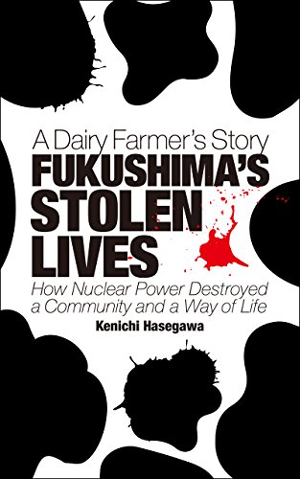 |
Fukushima's Stolen Lives: A Dairy Farmer's Story
by Kenichi Hasegawa
Published: June, 2016 "This is the story of Iitate, but it is also the story of Hasegawa, a man who had a lot to lose: a beautiful village steeped in natural history and time-honored traditions, a working dairy farm, a lovely home shared with his extended family, a close-knit community, and colleagues whom he considered close friends. Ultimately, the accident at Fukushima Daiichi—in concert with the profit-minded “nuclear power village” and failures of leadership at every level of government—not only took, but contaminated, all of it: the farm, the fields, the milk, the water, the harvest, the home, and a cherished way of life. Through it all, Hasegawa pursued the truth by meeting with journalists and taking his own radiation readings. He made sure that the residents in his hamlet of Maeta got what they needed—whether it was bottled water, or reliable information. He confronted lies and hypocrisy in the leadership where he found it. Ultimately, he took a leading role in preserving the interests of everyone and everything he cared about." —via Publisher
|
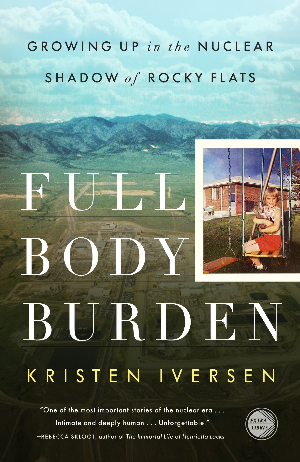 |
Full Body Burden: Growing Up in the Nuclear Shadow of Rocky Flats
by Kristen Iversen
Published: June, 2013 "Full Body Burden is a haunting work of narrative nonfiction about a young woman, Kristen Iversen, growing up in a small Colorado town close to Rocky Flats, a secret nuclear weapons plant once designated "the most contaminated site in America." It's the story of a childhood and adolescence in the shadow of the Cold War, in a landscape at once startlingly beautiful and—unknown to those who lived there—tainted with invisible yet deadly particles of plutonium. Based on extensive interviews, FBI and EPA documents, and class-action testimony, this taut, beautifully written book promises to have a very long half-life." —via Publisher
|
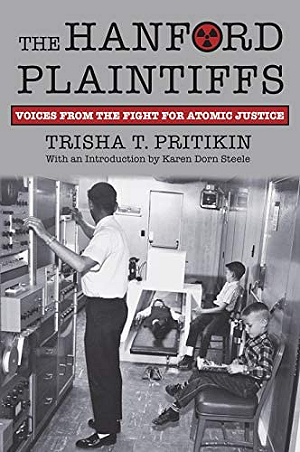 |
The Hanford Plaintiffs: Voices from the Fight for Atomic Justice
by Trisha T. Pritikin
Published: February, 2020 "For more than four decades beginning in 1944, the Hanford nuclear weapons facility in southeastern Washington State secretly blanketed much of the Pacific Northwest with low-dose ionizing radiation, the byproduct of plutonium production. For those who lived in the vicinity, many of them families of Hanford workers, the consequences soon became apparent as rates of illness and death steadily climbed—despite repeated assurances from the Atomic Energy Commission that the facility posed no threat. Trisha T. Pritikin, who has battled a lifetime of debilitating illness to become a lawyer and advocate for her fellow “downwinders,” tells the devastating story of those who were harmed in Hanford’s wake and, seeking answers and justice, were subjected to yet more suffering." —via Publisher
|
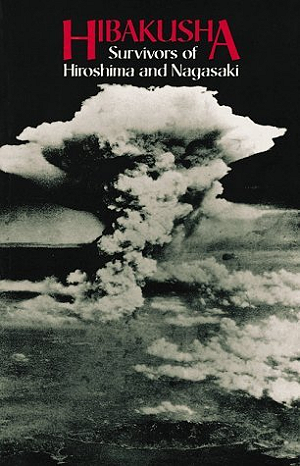 |
Hibakusha: Survivors of Hiroshima and Nagasaki
by Gaynor Sekimori
Published: December, 1986 "This book's 25 firsthand accounts by hibakusha-survivors of the atomic bombing of Hiroshima and Nagasaki in early August 1945-constitute an indictment of nuclear weapons far more eloquent than any polemic. Grim though their stories are, understanding what they went through may well be crucial to averting another nuclear tragedy." —via Publisher
|
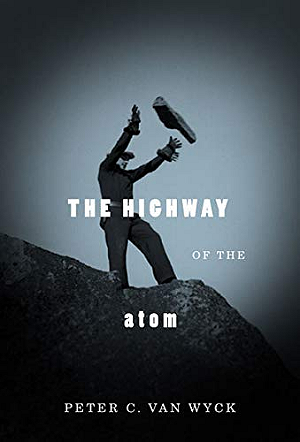 |
The Highway of the Atom
by Peter Van Wyck
Published: Octber, 2010 "A subarctic mine on the far eastern shores of Great Bear Lake provided Canadian uranium for the bombs detonated over Japan in August 1945. However, a complete history of Canada's involvement in the Manhattan Project and the development of the atomic bomb has been thwarted by restrictions on classified documents." —via Publisher
|
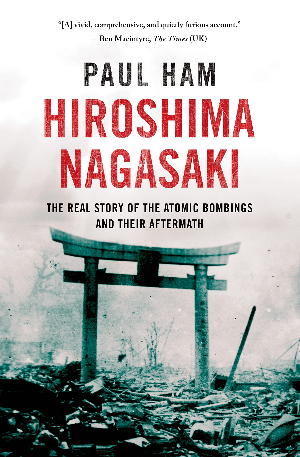 |
Hiroshima Nagasaki: The Real Story of the Atomic Bombings and Their Aftermath
by Paul Ham
Published: August, 2014 "In this harrowing history of the Hiroshima and Nagasaki bombings, Paul Ham argues against the use of nuclear weapons, drawing on extensive research and hundreds of interviews to prove that the bombings had little impact on the eventual outcome of the Pacific War. More than 100,000 people were killed instantly by the atomic bombs, mostly women, children, and the elderly. Many hundreds of thousands more succumbed to their horrific injuries later, or slowly perished of radiation-related sickness." —via Publisher
|
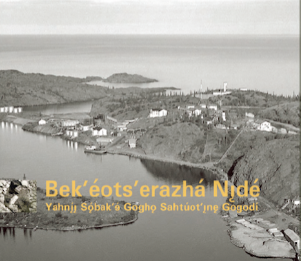 |
If Only We Had Known: the History of Port Radium as Told by the Sahtuot’ine
by the Deline Uranium Team
Published: October, 2005 "This book-length text’s release coincided with the 2005 report of the Canada-Délı̨nę Uranium Table. It emphasizes the Sahtúot’ı̨nę perspective on Port Radium, contextualized with local history and the personal and community impacts of the uranium mine." —via Sahtú Renewable Resources Board
|
 |
If You Poison Us: Uranium and Native Americans
by Peter H. Eichstaedt
Published: September, 1994 "The supply of uranium that fueled the Cold War came largely from the Four Corners area of the Colorado Plateau. Some of the richest deposits were found on the Navajo Reservation, where about one-fourth of the miners and millers were Native Americans. For nearly three decades in the face of growing evidence that uranium mining was dangerous, state and federal agencies neglected to warn the miners or to impose safety measures in the mines." —via Publisher
|
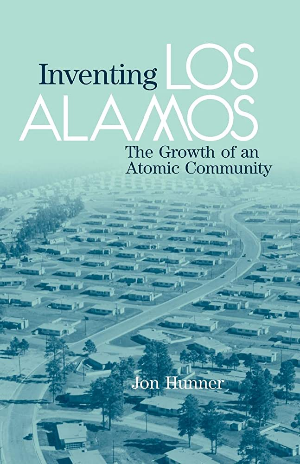 |
Inventing Los Alamos: The Growth of an Atomic Community
by Jon Hunner
Published: January, 2004 "Los Alamos, New Mexico, birthplace of the Atomic Age, is the community that revolutionized modern weaponry and science. An “instant city,” created in 1943, Los Alamos quickly grew to accommodate six thousand people―scientists and experts who came to work in the top-secret laboratories, others drawn by jobs in support industries, and the families. How these people, as a community, faced both the fevered rush to create an atomic bomb and the intensity of the subsequent cold-war era is the focus of Jon Hunner’s fascinating narrative history.." —via Publisher
|
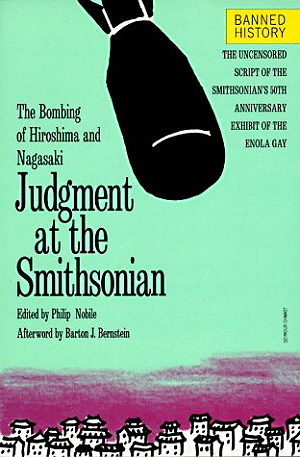 |
Judgment at the Smithsonian: The Bombing of Hiroshima and Nagasaki
by Philip Noble
Published: July, 1995 "Now published in its entirety, here is the Smithsonian's original Enola Gay document, with an introduction that covers the controversy and explains the issues at stake in remembering Hiroshima and Nagasaki 50 years later. Two closing chapters probe the enduring moral debate over the bombings and the strongly debated matter of an official apology to Japan." —via Publisher
|
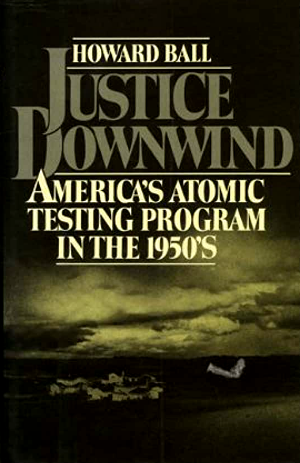 |
Justice Downwind: America’s Atomic Testing Program in the 1950’s
by Howard Ball
Published: March, 1986 "This is the astonishing story of how the United States exploded atomic weapons on its own soil. Pressing their case in the courts and in Congress, the downwind plaintiffs learned they were no match for a government even now extremely reluctant to admit its responsibility." —via Publisher
|
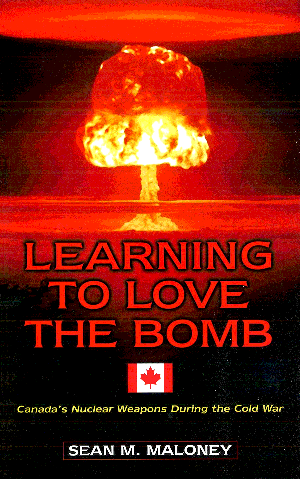 |
Learning to Love the Bomb: Canada's Nuclear Weapons During the Cold War
by Sean Maloney
Published: August, 2007 "In Learning to Love the Bomb, Sean M. Maloney explores the controversial subject of Canada’s acquisition of nuclear weapons during the Cold War. Based on newly declassified Canadian and U.S. documents, it examines policy, strategy, operational, and technical matters and weaves these seemingly disparate elements into a compelling story that finally unlocks several Cold War mysteries." —via Publisher
|
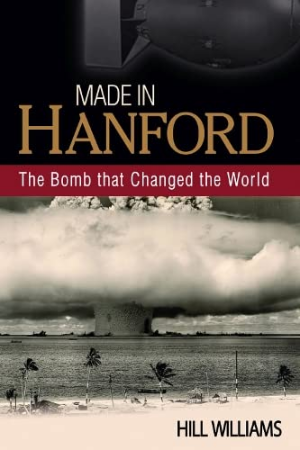 |
Made in Hanford: The Bomb That Changed the World
by Hill Williams
Published: April, 2011 "Hanford became the world's first plutonium factory. The incredibly complex operation was accomplished with a speed and secrecy unheard of today; few involved knew what they were building. But on August 9, 1945, when the "Fat Man" fell on Nagasaki, the workers understood their part in changing the world. Hanford's role did not end there. The facility produced plutonium throughout the Cold War. Some was used in tests conducted halfway around the world. Nuclear bombs were dropped on the Bikini and Enewetak Atolls, profoundly impacting the Marshall Islands people and forever altering their way of life. Through clear scientific explanations and personal reminiscences, Hill Williams traces Hanford's role in the amazing and tragic story of the plutonium bomb." —via Publisher
|
 |
Manual for Survival: a Chernobyl Guide to the Future
by Kate Brown
Published: March, 2019 "After 1991, international organizations from the Red Cross to Greenpeace sought to help the victims, yet found themselves stymied by post-Soviet political circumstances they did not understand. International diplomats and scientists allied to the nuclear industry evaded or denied the fact of a wide-scale public health disaster caused by radiation exposure. Efforts to spin the story about Chernobyl were largely successful; the official death toll ranges between thirty-one and fifty-four people. In reality, radiation exposure from the disaster caused between 35,000 and 150,000 deaths in Ukraine alone." —via Publisher
|
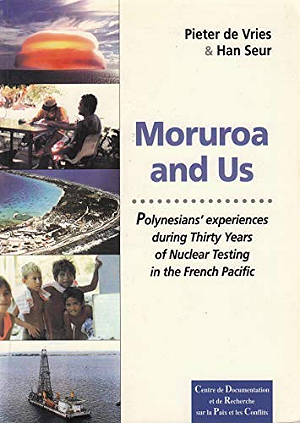 |
Moruroa and us: Polynesians experiences during thirty years of nuclear testing in the French Pacific
by Pieter De Vries
Published: January, 1997 "During the last thirty years thousands of Polynesian men and boys worked at Moruroa and Fangataufa, the two atolls in the Pacific where France conducted its nuclear tests. A curtain of silence has so far existed around their experiences, motivations and anxieties. In this report a representative number of former workers and islanders living in the vicinity of the test sites speak out. Their hidden histories and problems are revealed." —via Publisher
|
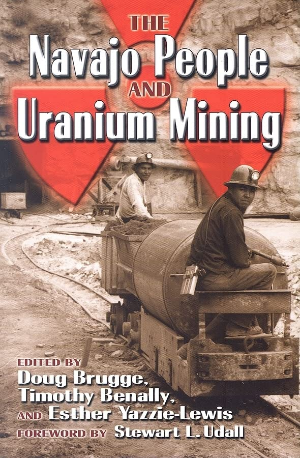 |
The Navajo People And Uranium Mining
by Doug Brugge
Published: November, 2006 "A team of Navajo people and supportive whites began the Navajo Uranium Miner Oral History and Photography Project from which this book arose. That project team, based at Tufts University School of Medicine in Boston, recruited the speakers who told their stories, which are reproduced here. There are also narrative chapters that assess the experiences of the Navajo people from diverse perspectives (history, psychology, culture, advocacy, and policy). While the points of view taken are similar, there is a range of perspectives as to what would constitute justice." —via Publisher
|
 |
No Immediate Danger: Prognosis for a Radioactive Earth
by Rosalie Bertell
Published: January, 1985 "A radiation research scientist's documented rebuttal to the claim by pro-nuclear officials that there are no harmful effects from low-level radiation from nuclear facilities." —via Publisher
|
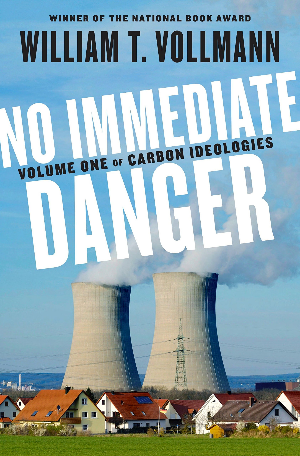 |
No Immediate Danger: Volume One of Carbon Ideologies
by William T. Vollmann
Published: April, 2018 "Vollmann begins No Immediate Danger, the first volume of Carbon Ideologies, by examining and quantifying the many causes of climate change, from industrial manufacturing and agricultural practices to fossil fuel extraction, economic demand for electric power, and the justifiable yearning of people all over the world to live in comfort. Turning to nuclear power first, Vollmann then recounts multiple visits that he made at significant personal risk over the course of seven years to the contaminated no-go zones and sad ghost towns of Fukushima, Japan, beginning shortly after the tsunami and reactor meltdowns of 2011. Equipped first only with a dosimeter and then with a scintillation counter, he measured radiation and interviewed tsunami victims, nuclear evacuees, anti-nuclear organizers and pro-nuclear utility workers." —via Publisher
|
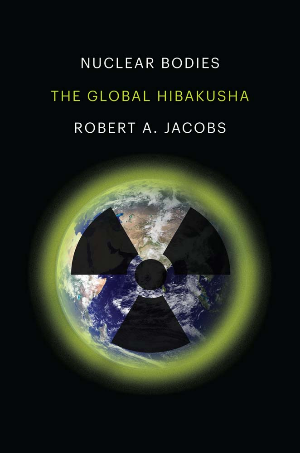 |
Nuclear Bodies: The Global Hibakusha
by Robert A. Jacobs
Published: March, 2022 "Robert A. Jacobs re-envisions the history of the Cold War as a slow nuclear war, fought on remote battlegrounds against populations powerless to prevent the contamination of their lands and bodies. His comprehensive account necessitates a profound rethinking of the meaning, costs, and legacies of our embrace of nuclear weapons and technologies." —via Publisher
|
 |
Nuclear Folly: A History of the Cuban Missile Crisis
by Serhii Plokhy
Published: April, 2021 "Serhii Plokhy’s Nuclear Folly offers an international perspective on the crisis, tracing the tortuous decision-making that produced and then resolved it, which involved John Kennedy and his advisers, Nikita Khrushchev and Fidel Castro, and their commanders on the ground. In breathtaking detail, Plokhy vividly recounts the young JFK being played by the canny Khrushchev; the hotheaded Castro willing to defy the USSR and threatening to align himself with China; the Soviet troops on the ground clearing jungle foliage in the tropical heat, and desperately trying to conceal nuclear installations on Cuba, which were nonetheless easily spotted by U-2 spy planes; and the hair-raising near misses at sea that nearly caused a Soviet nuclear-armed submarine to fire its weapons." —via Publisher
|
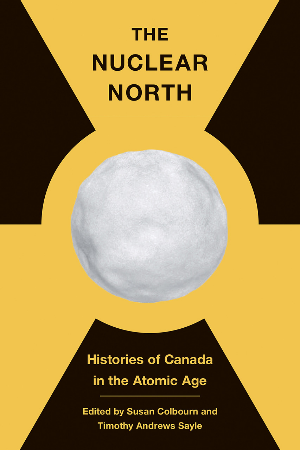 |
The Nuclear North: Histories of Canada in the Atomic Age
by Susan Colbourn
Published: October, 2020 "The Nuclear North investigates critical questions in these ongoing debates. Should Canada belong to international alliances that depend on the threat of using nuclear weapons for their own security? Should Canadian-produced nuclear technologies be sold on the export market to potential arms dealers? Does the country’s championing of global disarmament matter? What about the domestic costs of nuclear technologies and atomic research, including their impact on local communities and the environment?" —via Publisher
|
 |
Nuclear Physics: a very short introduction
by F. E. Close
Published: October, 2015 "In this Very Short Introduction Frank Close gives an account of how this area of physics has progressed, including the recognition of how heavy nuclei are built up in the cores of stars and in supernovae, the identification of quarks and gluons, and the development of quantum chromodynamics (QCD). Exploring key concepts such as the stability of different configurations of protons and neutrons in nuclei, Frank Close shows how nuclear physics brings the physics of the stars to Earth and provides us with important applications, particularly in medicine." —via Publisher
|
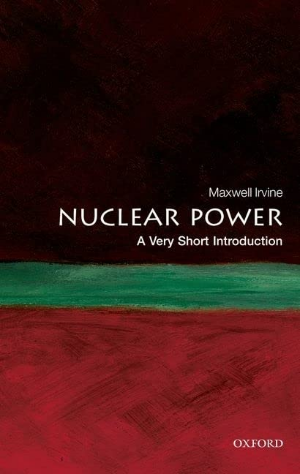 |
Nuclear Power: a very short introduction
by John M. Irvine
Published: July, 2011 "In this Very Short Introduction, Maxwell Irvine provides an informative and balanced overview of the entire subject. He presents a concise history of the development of nuclear physics leading up to the emergence of the nuclear power industry and discusses the nature of nuclear energy and the various aspects of public concern, including the risks of nuclear safety, the cost of its development, and the problems of waste disposal." —via Publisher
|
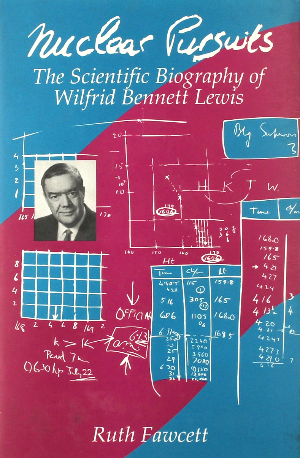 |
Nuclear Pursuits: The Scientific Biography of Wilfrid Bennett Lewis
by Ruth Fawcett
Published: June, 1994 "Nuclear Pursuits is the scientific biography of Wilfrid Bennett Lewis, the physicist who dominated nuclear research and the development of nuclear power in Canada for nearly three decades, from the end of World War II until his retirement in 1973. The development of the CANDU reactor was his most stunning achievement." —via Publisher
|
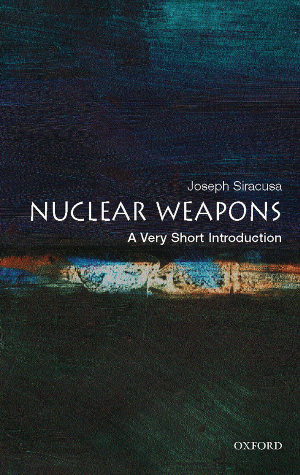 |
Nuclear Weapons: a very short introduction
by Joseph M. Siracusa
Published: April, 2008 "In this Very Short Introduction, Joseph M. Siracusa, an internationally respected authority on nuclear arms, provides a comprehensive, accessible, and at times chilling overview of the most deadly weapon ever invented. Siracusa explains the history of the arms race and the politics of the bomb, ranging from the technology of nuclear weapons, to the revolutionary implications of the H-bomb and the politics of nuclear deterrence." —via Publisher
|
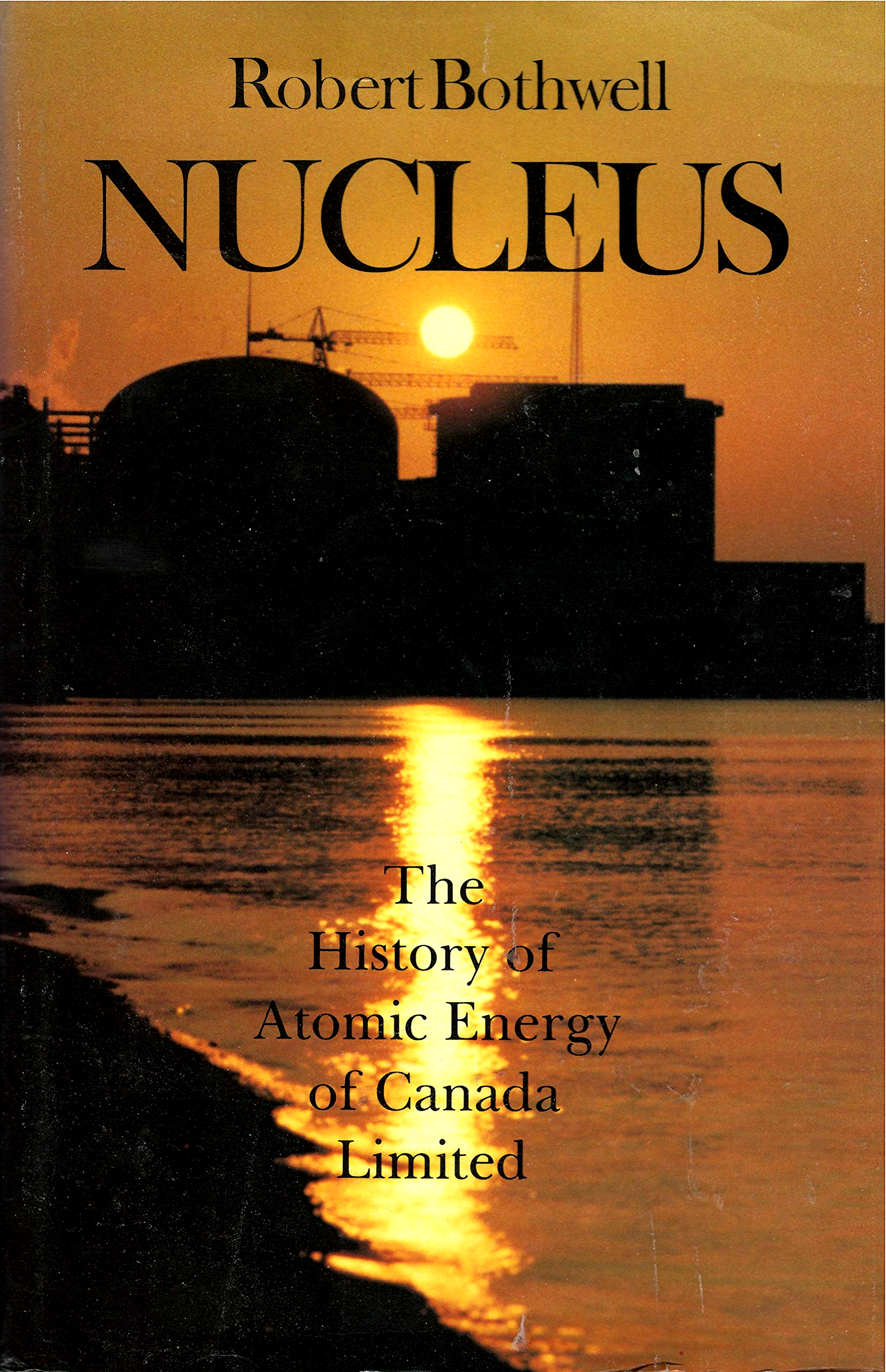 |
Nucleus: The History Of Atomic Energy Of Canada Limited
by Robert Bothwell
Published: January, 1988 "Robert Bothwell traces the development of nuclear energy in Canada from its origins during World War II to its status during the late 1980s." —via Publisher
|
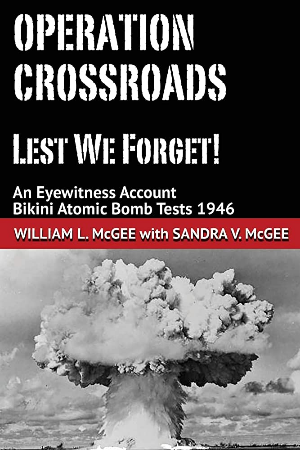 |
Operation Crossroads - Lest We Forget! An Eyewitness Account, Bikini Atomic Bomb Tests 1946
by William L. McGee
Published: June, 2016 "In the summer of 1946, McGee was one of the 42,000 military, scientists, and civilian personnel assembled at the remote Bikini Atoll in the Marshall Islands. The objective: to conduct postwar testing of the atomic bomb on wartime vessels, equipment, and animals. Code name: Operation CROSSROADS." —via Publisher
|
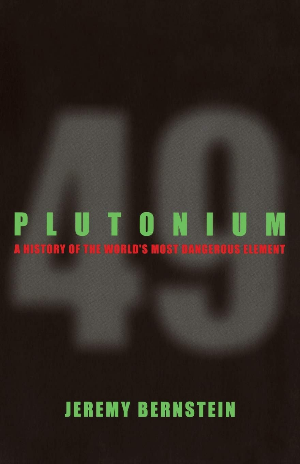 |
Plutonium: A History of the World's Most Dangerous Element
by Jeremy Bernstein
Published: March, 2007 "The history of plutonium is as strange as the element itself. When scientists began looking for it, they did so simply in the spirit of inquiry, not certain whether there were still spots to fill on the periodic table. But the discovery of fission made it clear that this still-hypothetical element would be more than just a scientific curiosity-it could be the main ingredient of a powerful nuclear weapon." —via Publisher
|
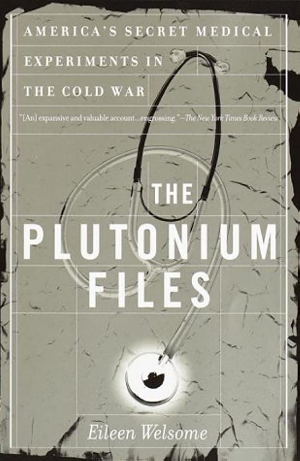 |
The Plutonium Files: America's Secret Medical Experiments in the Cold War
by Eileen Welsome
Published: October, 1999 "Pulitzer Prize-winning reporter Eileen Welsome reveals for the first time the breadth of the extraordinary fifty-year cover-up surrounding the plutonium injections, as well as the deceitful nature of thousands of other experiments conducted on American citizens in the postwar years. Welsome's remarkable investigation spans the 1930s to the 1990s and draws upon hundreds of newly declassified documents and other primary sources to disclose this shadowy chapter in American history." —via Publisher
|
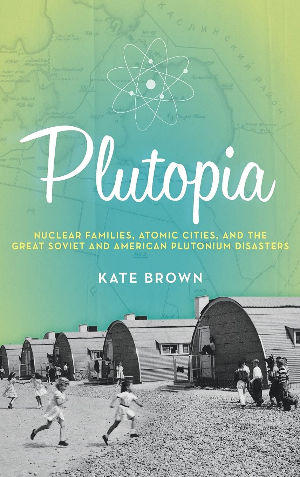 |
Plutopia: Nuclear Families, Atomic Cities, and the Great Soviet and American Plutonium Disasters
by Kate Brown
Published: April, 2013 "Brown draws on official records and dozens of interviews to tell the stories of Richland, Washington and Ozersk, Russia-the first two cities in the world to produce plutonium. To contain secrets, American and Soviet leaders created plutopias--communities of nuclear families living in highly-subsidized, limited-access atomic cities. Brown shows that the plants' segregation of permanent and temporary workers and of nuclear and non-nuclear zones created a bubble of immunity, where dumps and accidents were glossed over and plant managers freely embezzled and polluted." —via Publisher
|
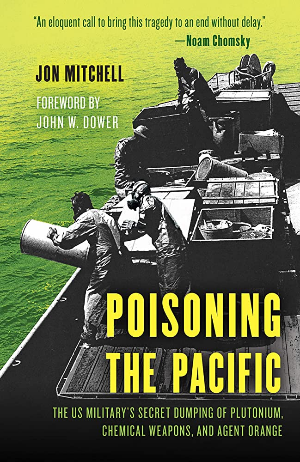 |
Poisoning the Pacific: The US Military's Secret Dumping of Plutonium, Chemical Weapons, and Agent Orange
by Jon Mitchell
Published: October, 2020 "Caught in a geopolitical grey zone, US territories have been among the worst affected by military contamination, including Guam, Saipan, and Johnston Island, the final disposal site of apocalyptic volumes of chemical weapons and Agent Orange. Accompanying this damage, US authorities have waged a campaign of cover-ups, lies, and attacks on the media, which the author has experienced firsthand in the form of military surveillance and attempts by the State Department to impede his work. Now, for the first time, this explosive book reveals the horrific extent of contamination in the Pacific and the lengths the Pentagon will go to conceal it." —via Publisher
|
 |
Radiation Brain Moms and Citizen Scientists: the Gender Politics of Food Contamination after Fukushima
by Aya Hirata Kimura
Published: August, 2016 "Following the Fukushima Daiichi Nuclear Power Plant disaster in 2011 many concerned citizens—particularly mothers—were unconvinced by the Japanese government’s assurances that the country’s food supply was safe. They took matters into their own hands, collecting their own scientific data that revealed radiation-contaminated food. By highlighting the challenges these citizen scientists faced, Kimura provides insights into the complicated relationship between science, foodways, gender, and politics in post-Fukushima Japan and beyond." —via Publisher
|
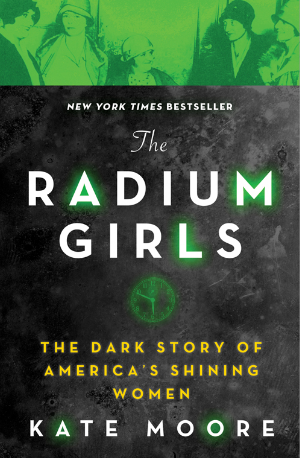 |
The Radium Girls: The Dark Story of America's Shining Women
by Kate Moore
Published: July, 2017 "Written with a sparkling voice and breakneck pace, The Radium Girls fully illuminates the inspiring young women exposed to the “wonder” substance of radium, and their awe-inspiring strength in the face of almost impossible circumstances. Their courage and tenacity led to life-changing regulations, research into nuclear bombing, and ultimately saved hundreds of thousands of lives..." —via Publisher
|
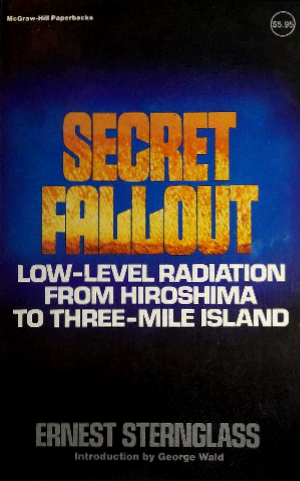 |
Secret Fallout: Low-Level Radiation from Hiroshima to Three Mile Island
by Ernest Sternglass
Published: January, 1981 "The author, Professor of radiation physics at the University of Pittsburgh, presents evidence for the cumulative effects of low-level radiation on health. In the early 1960s, when nuclear testing created fallout radioactivity, Dr. Sternglass states that he discovered a related increase in fetal deaths, infant mortality, and certain kinds of cancer." —via Publisher
|
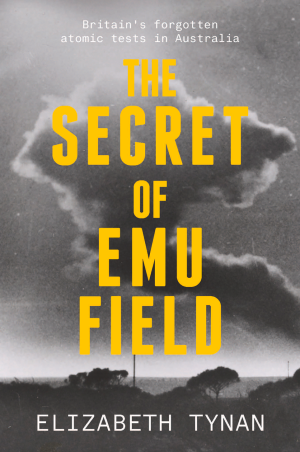 |
The Secret of Emu Field: Britain's forgotten atomic tests in Australia
by Elizabeth Tynan
Published: May, 2022 "Only at Emu Field in October 1953 did a terrifying black mist speed across the land after an atomic bomb detonation, bringing death and sickness to Aboriginal populations in its path. Elizabeth Tynan reveals the story of a cataclysmic collision between an ancient Aboriginal land and the post-war Britain of Winston Churchill and his gung-ho scientific advisor Frederick Lindemann. The presence of local Anangu people did not interfere with Churchill's geopolitical aims and they are still paying the price." —via Publisher
|
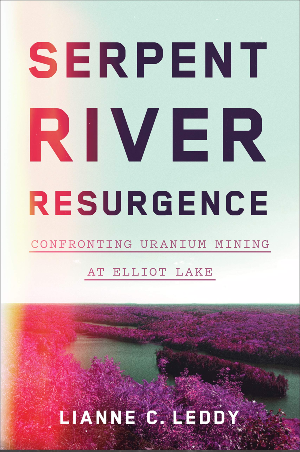 |
Serpent River Resurgence: Confronting Uranium Mining at Elliot Lake
by Lianne Leddy
Published: March, 2022 "Drawing on extensive archival, participant interview, and newspaper sources, Lianne C. Leddy examines the environmental and political power relationships that affected her homeland in the Cold War period. Focusing on Indigenous-settler relations, the environmental and health consequences of the uranium industry, and the importance of traditional uses of land and what happens when they are compromised, Serpent River Resurgence explores how settler colonialism and Anishinaabe resistance remained potent forces in Indigenous communities throughout the second half of the twentieth century." —via Publisher
|
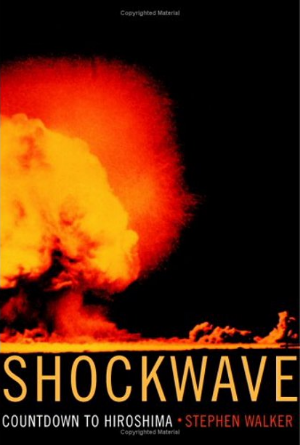 |
Shockwave: Countdown to Hiroshima
by Stephen Walker
Published: May, 2006 "The story of the bombing of Hiroshima presented in a new and dramatic way: a minute-by-minute account told from multiple perspectives, both in the air and on the ground. British feature and documentary director Stephen Walker tells the story of the bombing of Hiroshima in a way only a filmmaker can―not as a dry history of the sad, regrettable, mission, but as an immediate and perilous drama. Walker has extensively interviewed American soldiers, Los Alamos scientists, and Japanese survivors that were involved in the bombing, and thus is able to tell the story through truly alive-on-the-page characters." —via Publisher
|
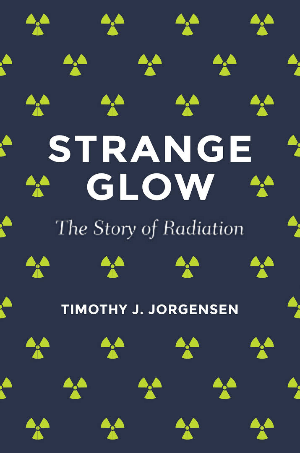 |
Strange Glow: the Story of Radiation
by Timothy J. Jorgensen
Published: August, 2017 "Jorgensen introduces key figures in the story of radiation―from Wilhelm Roentgen, the discoverer of x-rays, and pioneering radioactivity researchers Marie and Pierre Curie, to Thomas Edison and the victims of the recent Fukushima Daiichi nuclear power plant accident. Tracing the most important events in the evolution of radiation, Jorgensen explains exactly what radiation is, how it produces certain health consequences, and how we can protect ourselves from harm. He also considers a range of practical scenarios such as the risks of radon in our basements, radiation levels in the fish we eat, questions about cell-phone use, and radiation's link to cancer." —via Publisher
|
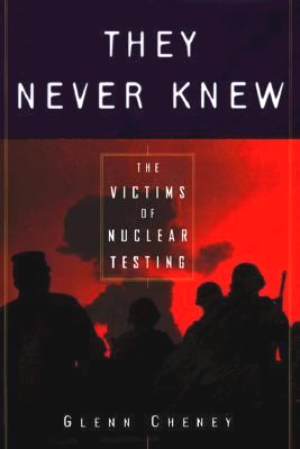 |
They Never Knew: The Victims of Nuclear Testing
by Glenn Alan Cheney
Published: October, 1996 "An account of the effects of U.S. nuclear bomb testing, this book tells the story of the military members, workers, and local inhabitants who contracted fatal diseases, especially cancer, as a result of the testing program in Nevada and in the South Pacific. The attempts of many victims and their families to hold the government agencies responsible are documented. Examines the American government's role in developing nuclear weapons and conducting atomic testing, focusing on the effects of radiation on humans and the victims' attempts to sue the government for compensation." —via Publisher
|
 |
U.S. Nuclear Weapons in Canada
by John Clearwater
Published: October, 1999 "In this second volume of his nuclear weapon series, John Clearwater continues to investigate the presence of American nuclear weapons in Canada. In Canadian Nuclear Weapons, Clearwater told the story of nuclear weapons that were in the hands of Canadian forces during the Cold War. In U.S. Nuclear Weapons in Canada, he goes further, looking at nuclear weapons held by American forces on Canadian soil. His purpose is to bring together until-recently secret information about the nature of the nuclear weapons stored, stationed, or lost in Canada by the United States Air Force and the United States Navy, and combines it with known information about the systems in the U.S. nuclear arsenal." —via Publisher
|
 |
Under the Cloud: The Decades of Nuclear Testing
by Richard L. Miller
Published: September, 1986 "Documents the history of America's nuclear testing program, emphasizing the effects of the radioactive clouds the test blasts produced. In the 1950s and 1960s, over 100 aboveground atomic bombs were exploded in the Nevada desert. Miller gives us absolutely arresting accounts of most of them. He describes the goals, the explosion, and the yield, and includes fascinating details, many times from contemporary accounts by news reporters, bomb droppers, and others. Miller saves most of the detail, interestingly given, for descriptions of the paths of the nuclear clouds and the locations and character of the fallout all over the country. He deals extensively with coverups relating to fallout effects on humans and animals." —via Publisher
|
 |
Voices From Chernobyl: The Oral History of a Nuclear Disaster
by Svetlana Alexievich [Translated by Keith Gessen]
Published: June, 2005 "On April 26, 1986, the worst nuclear reactor accident in history occurred in Chernobyl and contaminated as much as three quarters of Europe. Voices from Chernobyl is the first book to present personal accounts of the tragedy. Journalist Svetlana Alexievich interviewed hundreds of people affected by the meltdown—from innocent citizens to firefighters to those called in to clean up the disaster—and their stories reveal the fear, anger, and uncertainty with which they still live. Composed of interviews in monologue form, Voices from Chernobyl is a crucially important work of immense force, unforgettable in its emotional power and honesty." —via Publisher
|
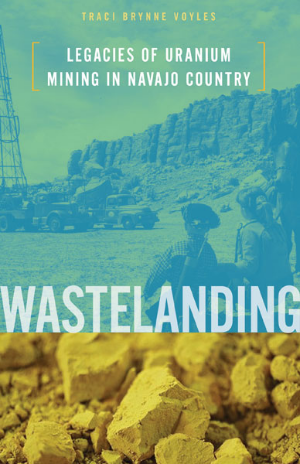 |
Wastelanding: Legacies of Uranium Mining in Navajo Country
by Traci Brynne Voyles
Published: May, 2015 "Wastelanding tells the history of the uranium industry on Navajo land in the U.S. Southwest, asking why certain landscapes and the peoples who inhabit them come to be targeted for disproportionate exposure to environmental harm. Uranium mines and mills on the Navajo Nation land have long supplied U.S. nuclear weapons and energy programs. By 1942, mines on the reservation were the main source of uranium for the top-secret Manhattan Project. Today, the Navajo Nation is home to more than a thousand abandoned uranium sites. Radiation-related diseases are endemic, claiming the health and lives of former miners and nonminers alike." —via Publisher
|
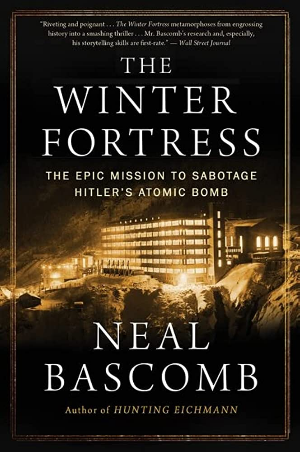 |
The Winter Fortress: The Epic Mission to Sabotage Hitler’s Atomic Bomb
by Neal Bascomb
Published: May, 2016 "In 1942, the Nazis were racing to complete the first atomic bomb. All they needed was a single, incredibly rare ingredient: heavy water, which was produced solely at Norway’s Vemork plant. Under threat of death, Vemork’s engineers pushed production into overdrive. If the Allies could not destroy the plant, they feared the Nazis would soon be in possession of the most dangerous weapon the world had ever seen. But how would the Allied forces reach the castle fortress, set on a precipitous gorge in one of the coldest, most inhospitable places on earth?" —via Publisher
|
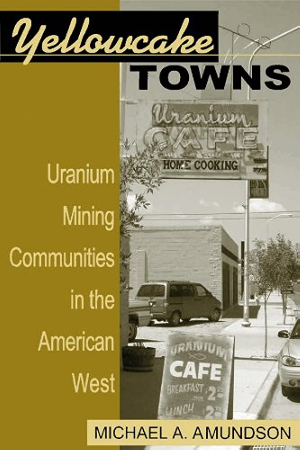 |
Yellowcake Towns: Uranium Mining Communities in the American West
by Michael A. Amundson
Published: June, 2002 "Michael Amundson presents a detailed analysis of the four mining communities at the hub of the twentieth-century uranium booms: Moab, Utah; Grants, New Mexico; Uravan, Colorado; and Jeffrey City, Wyoming. He follows the ups and downs of these "Yellowcake Towns" from uranium's origins as the crucial element in atomic bombs and the 1950s boom to its use in nuclear power plants, the Three Mile Island accident, and the 1980s bust. Yellowcake Towns provides a look at the supply side of the Atomic Age and serves as an important contribution to the growing bibliography of atomic history." —via Publisher
|